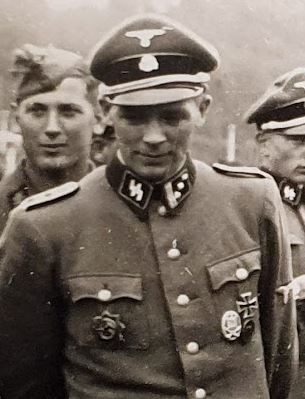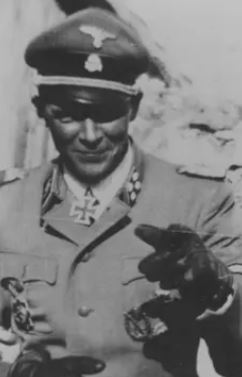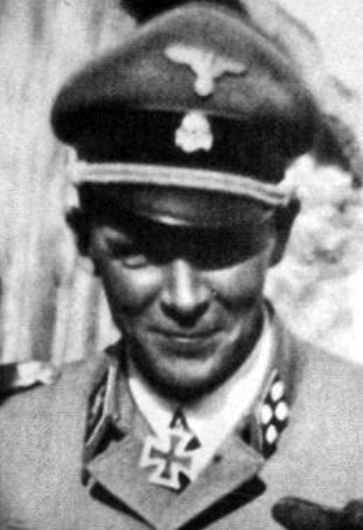Kniep, Walter (Waffen SS)
- Date of birth:
- December 13th, 1909 (Lorenzen/Easternprussia, Germany)
- Date of death:
- April 2nd, 1944 (Froze, Thouars, Vienne, France)
- Buried on:
- German War Cemetery Mont-de-Huisnes
Row: 55. Grave: 135. - Service number:
- SS-Nr.: // NSDAP-Nr.:
- Nationality:
- German
Biography
Walter Kniep died on 22nd April 1944 near Tours as Kommandeur SS-Panzer-Abteilung 17 "Götz von Berlichingen".
00.00.1927: police school in Brandenburg
00.00.1930: Berlin police force
00.02.1934: Political Readiness Ellwangen
00.00.1934: joined the SS
00.00.1935-00.00.1936: SS-Junker, SS-Junkerschule Braunschweig
20.04.1936: promoted to SS-Untersturmführer
00.00.1938: promoted to SS-Obersturmführer
00.00.1939-00.00.1940: SS-Ostuf, Chef, 1. Batterie, SS-Flak-Abteilung, Panzerverband Kempf then SS-VT - campaign in Poland then in the West
00.00.1941: promoted to SS-Hauptsturmführer
00.06.1941: SS-Hstuf, Chef, 3. Kompanie, SS-Infanterie-Regiment (motorisiert) "Der Führer", SS-Division (mot.) 'Reich'
07.11.1941: severely WIA to the head and shoulder
00.03.1942: SS-Hstuf, IIa, 2. SS-Panzer-Division 'Das Reich'
00.10.1942: SS-Hstuf, Kdr, SS-Sturmgeschütz-Abteilung 2, 2. SS-Panzer-Division 'Das Reich'
20.04.1943: promoted to SS-Sturmbannführer
00.06.1943: fightings in Belgorod -
00.08.1943: SS-Stubaf, Kdr, SS-Panzer-Abteilung 17, 17. SS-Panzergrenadier-Division "Götz von Berlichingen" - France
02.04.1944: accidentaly killed ivo Frozes, Vienne, region of Thouars - died from the accidental discharge of his pistol during target practice
Do you have more information about this person? Inform us!
- Period:
- Second World War (1939-1945)
- Rank:
- SS-Obersturmführer (Lieutenant)
- Unit:
- Chef, 1. Batterie, SS-Flak-Abteilung, SS-VT
- Awarded on:
- June 3rd, 1940
- Period:
- Second World War (1939-1945)
- Awarded on:
- April 20th, 1941
- Period:
- Second World War (1939-1945)
- Rank:
- SS-Hauptsturmführer (Captain)
- Unit:
- Chef, 1. Batterie, SS-Flak-Abteilung, SS-VT
- Awarded on:
- July 22nd, 1941
- Period:
- Second World War (1939-1945)
- Rank:
- SS-Hauptsturmführer (Captain)
- Unit:
- Chef, 3. Kompanie, SS-Infanterie-Regiment (motorisiert) "Der Führer", SS-Division (mot.) 'Reich'
- Awarded on:
- November 1941
- Period:
- Second World War (1939-1945)
- Rank:
- SS-Hauptsturmführer (Captain)
- Unit:
- Chef, 3. Kompanie, SS-Infanterie-Regiment (motorisiert) "Der Führer", SS-Division (mot.) 'Reich'
- Awarded on:
- November 11th, 1941
"Already in the west SS-Hstuf Kniep showed special bravery and personal commitment as commander of a 2cm Flak Company. SS-Hstuf Kniep's mission in the east saw him leading 3./SS-Rgt "DF". To his company SS-Hstuf Kniep was always an example of personal bravery. In addition to his personal commitment, SS-Hstuf Kniep always acts prudently and led his company very well.
During the hard and heavy fighting near Jelnja SS-Hstuf Kniep led from the front of his company, on 27.7.41, storming the height west of Panteleff with special momentum. The attack advanced so fast that the Russians, who were just about to occupy the height with a regiment, reacted too slowly to the attack. The machine guns of the 3rd company fired into the enemy units, as the height west of Panteleff was very important for the continuation of the heavy fighting at Jelnja. Kniep was the farthest eastward with his company in the following combat section assigned for the defense. Again, Kniep was the soul of his company's resistance. Despite the constant heaviest artillery fire, which fell on the thin line - due to the width of the section - of the 3rd company, Kniep was almost fanatical in his desire to hold the defensive position. The importance of the height for the Russians could be seen from the fact that they sent everything they could assemble in their assault against the 3rd company and supported these attacks with tanks. Where the Russians managed to reach the 3rd Company line at hand grenade range or where the Russian artillery fire broke through the 3rd Company's thin defensive line, Kniep appeared without regard for his life and helped restore the situation. Thus the 3rd company held its position under the careful leadership and energy of SS-Hstuf Kniep and caused the Russians severe losses.
On 12.8.41, when the battalion was the divisional reserve, the 3rd company was deployed to close the gap between the SS-Rgt. "D" and the 15th ID, into which the Russians had penetrated. The Russians had taken up position in a wood with dense undergrowth and fought tooth and nail to retain the position. In close combat, SS-Hstuf Kniep cleared the forest at the head of his company and completed the mission with energy and daredevilish regard for his life.
On the night of 7/8.41 the Makoshin bridgehead was extended. Here also the 3rd company played a large part, since it succeeded in making the connection with the Kradschutzen strongly pressed by the Russians on the south bank. Here too, SS-Hstuf Kniep was at the head of his company crossing the Desna and penetrating the dense Kussel area occupied by the Russians on the bank without regard for his life
On 20.8.41 SS-Hstuf Kniep showed his personal bravery and good, prudent leadership of his company in the fights for Romny. Kniep was commissioned to lead a night attack and clear the the Russians from the southern part of Pustowejtowka with his company and then to seal it off to the east. SS-Hstuf Kniep advanced into the village at the head of an assault group and cleared it in close combat with hand grenades. In these actions the Russian suffered great losses of men and material.
A few days later at Ssakunowo SS-Hstuf Kniep, again at the front of his company, cleared the local area against overpowering numerical superiority. The subsequent massive counter-attacks of the Russians broke again and again on the exemplary defensive line of the 3./SS-Rgt "DF" under the leadership of SS-Hstuf Kniep.
In summary, it can be said that SS-Hstuf Kniep is an exemplary company commander, who will always be an example of soldierly duty and personal commitment. The men of I./SS-Rgt "DF" believe SS-Hstuf Kniep is worthy of the award of the German Cross in Gold.”
SS-Ostubaf Otto Kumm, Regimentsführer:
“Kniep is one of the bravest company commanders of the regiment. Through his personal commitment he has given the company an unshakable attitude, which has shown itself especially in the heavy defensive battles in the Jelnja bow. There the 3rd company had to hold the most endangered section and endure the heaviest artillery fire.
In the attack along the highway south of Noshaisk, Kniep was the first man to cross the Ushat amidst strong hostile fire, destroying the explosive charges at the bridge and thus saving the bridge from destruction. For his bravery, which has been shown again and again, he has received the highest recognition.”
- Period:
- Second World War (1939-1945)
- Awarded on:
- 1942
- Period:
- Second World War (1939-1945)
- Awarded on:
- 1942
- Period:
- Second World War (1939-1945)
- Rank:
- SS-Sturmbannführer (Major)
- Unit:
- Kommandeur, SS-Sturmgeschütz-Abteilung 2, 2. SS-Panzer-Division "Das Reich"
- Awarded on:
- August 14th, 1943
“On the 08.07.1943, following the breakthrough of the strong enemy defensive system north of Belgorod (in which the SS-Sturmgeschütz-Abteilung “Das Reich” had a decisive role), the Division had the task of covering the long open east flank of the II. SS-Panzer-Korps with the bulk of its units. Meanwhile the Division’s armoured group was to launch a thrust to the west in order to break the enemy resistance blocking the path of the SS-Pz.Gren.Div. ‘Leibstandarte SS Adolf Hitler’ via a flank attack.
On the early morning of the 08.07.1943 the enemy advanced against the positions of the Panzergrenadier Regiments ‘Deutschland’ and ‘Der Führer’ with strong infantry and tank forces. Their goal was to launch a decisive counterattack with the aim of retaking a commanding hill near Kalinin that they had lost on the previous day. From here they would cut the supply line to both the Division and the whole Korps. Aerial reconnaissance had reported large enemy tank assemblies, which were confirmed later by the observation of 170 deployed enemy tanks.
The Sturmgeschütz-Abteilung had a Batterie present with both the ‘Deutschland’ and ‘Der Führer’ Panzergrenadier regiments, with the third being held back as a divisional reserve. After the enemy infantry had been separated from their tanks, the first wave of enemy armour rolled over our own positions and thrusted to a depth of 9 km into our territory.
At this time almost all wire communications of the Division had been destroyed.
In this ominous situation SS-Sturmbannführer Kniep decided on his own initiative to gather his Batterien together, even though two were already heavily engaged in the hard defensive battles. From an assembly area to the rear, he then moved out with his vehicles as a heavily armoured fist towards the enemy tank forces.
In the ensuing fluid battle, which lasted for hours, Kniep was able to crush the enemy at the head of his Abteilung. His Sturmgeschütze destroyed 51 enemy tanks for the loss of just one of their own, with Kniep personally accounting for 5 of these.
Through this decisive and aggressive action, one primarily to SS-Sturmbannführer Kniep’s credit, the enemy armoured breakthrough was smashed in a timely manner. His actions also ensured that the bulk of the remaining enemy tanks - now leaderless - could be destroyed by the other AT weapons of the Division. A large number were eventually taken down by the SS Panzergrenadiers equipped with close combat weapons, some of whom were inspired into a true hunting mode through the bold and successful example of SS-Sturmbannführer Kniep and his Sturmgeschütze. In total 92 enemy tanks were destroyed in this battle.
In order to exploit the tactical success achieved by SS-Sturmbannführer Kniep, the SS-Pz.Gren.Rgt. ‘Deutschland’ immediately launched their own attack and were able to significantly improve our frontline. These newly won positions would serve as the jump-off point for the later successful attack of the 2nd Regiment of the SS-Pz.Gren.Div. ‘Leibstandarte Adolf Hitler’ on the 09.07.1943. In addition to this the munitions, fuel and other supply dumps that were already in reach of the enemy armoured thrust, as well as the tightly clustered staff units (who had been forced into a small area due to the situation and terrain), were spared of major losses.
SS-Sturmbannführer Kniep is a brave, decisive and dutiful Abteilung commander, who has shown himself to be a master of employing his Sturmgeschütze in such a way as to inflict maximum losses on the enemy for the smallest of friendly losses. Because of this the Division was greatly helped in its successes and did not have to suffer greater losses in men and materiel.
In the fighting north of Belgorod during the time period 05-17.07.1943 SS-Sturmbannführer Kniep and his Abteilung were able to destroy 129 enemy tanks for the loss of just 2 of their own vehicles. He and his Abteilung also had a major share in the successful breakthroughs of the enemy defensive lines near Beresoff and Lutschki on the 05. and 07.07.1943.
SS-Sturmbannführer Kniep has already been awarded the German Cross in Gold on the 15.11.1941 as the first member of the Division to be so honoured.”
- Period:
- Second World War (1939-1945)
- Awarded on:
- 1943
Sources
- Photo 1:
- Photo 2:
- Photo 3:
- Photo: HISTOREICH: SS-Sturmbannführer Walter Kniep. 17 SS Division Götz von Berlichingen
- - SCHERZER, VEIT & FARWICK, WERNER, Die Ritterkreuzträger der Sturmartillerie 1939-1945, Verlag Veit Scherzer, 2011.
- Die Ordensträger der Deutschen Wehrmacht (CD), VMD-Verlag GmbH, Osnabrück, 2002
- Fellgiebel W.P., Elite of the Third Reich, The recipients of the Knight's Cross of the Iron Cross 1939-1945: A Reference, Helion & Company Limited, Solihull, 2003, ISBN 1-874622-46-9
- Patzwall K., Scherzer V., Das Deutsche Kreuz 1941-1945, Geschichte und Inhaber Band II, Verlag Klaus D. Patzwall, Norderstedt, 2001, ISBN 3-931533-45-X
- Ritterkreuz Archiv II/2009, Veit Scherzer, Ranis, Juni 2009, ISSN 1866-4709
- Die Träger des Ritterkreuzes des Eisernen Kreuzes 1939-1945















